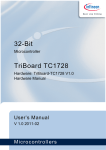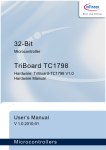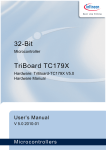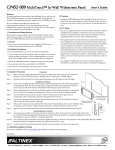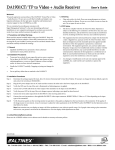Download Altinex AC301-201 User`s guide
Transcript
TP115TP115-201/202 Video+Audio+IR+RS232 Video+Audio+IR+RS232 to TP User’s Guide Welcome! We greatly appreciate your purchase of the TP115-201/202 Video + Audio+ IR+ RS-232 to Twisted Pair Transmitter/Receiver. We are sure you will find it reliable and simple to use. Superior performance for the right price, backed by solid technical and customer support is what ALTINEX has to offer. 1.3 Cleaning We are committed to providing our customers with Signal Management Solutions® to the most demanding audiovisual installations at competitive pricing and we welcome you to join the ranks of our many satisfied customers throughout the world. 1.4 FCC Notice • Clean only with a dry cloth. Never use strong detergents or solvents such as alcohol or thinner. Do not use a wet cloth or water to clean the unit. Do not open the unit to clean. • This device complies with Part 15 of the FCC Rules. Operation is subject to the following two conditions: (1) This device may not cause harmful interference, and (2) this device must accept any interference received, including interference that may cause undesired operation. 1. Precautions and Safety Warnings • This equipment has been tested and found to comply with the limits for a Class A digital device, pursuant to Part 15 of the FCC Rules. These limits are designed to provide reasonable protection against harmful interference when the equipment is operated in a commercial environment. This equipment generates, uses, and can radiate radio frequency energy and, if not installed and used in accordance with the instructions found herein, may cause harmful interference to radio communications. Operation of this equipment in a residential area is likely to cause harmful interference in which case the user will be required to correct the interference at his own expense. Please read this manual carefully before using your TP115-201/202. Keep this manual handy for future reference. These safety instructions are to ensure the long life of your TP115-201/202 and to prevent fire and shock hazards. Please read them carefully and heed all warnings. 1.1 General • Qualified ALTINEX service personnel or their authorized representatives must perform all service. 1.2 Installation Precaution • To prevent fire or shock, do not expose units to water/moisture. Do not place in direct sunlight, near heaters or heat-radiating appliances, or near liquids. Exposure to sunlight, smoke, or steam can harm internal components. • Any changes or modifications to the unit not expressly approved by ALTINEX, Inc. could void the user’s authority to operate the equipment. • Handle carefully; dropping or jarring can damage the unit. Do not pull on any cables that are attached to the TP115-201/202. 2. Installation Procedure Note: Download and read the online manual to become familiar with this product and for additional details. LEDs Power: Signal: EDID: Activity: Data Transmitting IR/RS-232 data requires the construction of a cable as shown. For best results use multi-conductor stranded wire, 24-28 AWG, and the terminal block connector with captive screws (included). IR/RS-232 activity may cause momentary "glitches" or "muting" in the audio quality. Audio Analog audio is available for VGA input; there is no digital audio with VGA input. Component/YPbPr audio accepts digital (coax) or optical audio. Local audio is the same format as the input audio. Step 1. Place the TP115-201 Transmitter and TP115-202 Receiver at their destinations and apply power; ALTINEX logos illuminate. Step 2. Connect the video and audio output from the local device (PC, DVD, etc.) to the VGA/COMPONENT and AUDIO inputs on the TP115-201. Cables are provided for a standard PC connection. Step 3. Connect the local outputs (video and audio) on the TP115-201 to the local display and/or speakers if available. The local outputs are identified by arrows pointing out of the TP115-201. Step 4. Connect a CAT-5 cable between the TP connectors of the two units. For best results use ALTINEX low skew cable. Step 5. Connect the TP115-202 Receiver to a display and speakers (or other audio receiving device). Step 6. Verify the picture quality on the receiving display is equivalent to the quality as displayed on the local monitor. If the quality of the image is poor or nonexistent, it may be necessary to adjust the video equalization on the TP receiver. Adjust the equalization incrementally and wait between adjustments as some displays respond slowly to changes in the incoming video signal. Step 7. For control wiring, if transmitting IR data from the receiver to the transmitter, install the optional IR Emitter to the 3.5 mm mono jack labeled IR OUT. The emitter end of the cable should be place on or near the IR eye of the receiving device. See Section 7 for more details. 3. Limited Warranty/Return Policies Please see the ALTINEX website at www.altinex.com for details on warranty and return policies. 400-0554-002 Audio Wiring ALTINEX logo is illuminated. GREEN= VGA, RED=Component (YPbPr) GREEN= Using local monitor EDID. RED= Using ALTINEX internal EDID. Shows data traffic on the IR or RS-232 data lines. 1 Control Wiring TP115TP115-201/202 User’s Guide 4. Technical Specifications Specifications are subject to change. See www.altinex.com for up-to-date information. Features/Description Input Connectors RGBHV or YPbPr Stereo Audio Power IR IN, RS-232, +5V Out Output Connectors Local Monitor Local Audio Main Output IR Compatibility PC Signal Resolutions HDTV Resolutions Accessories Included Cable, VGA 6 ft 15-pin HD Cable, Audio 3.5 mm Power Adapter Terminal Blocks Miscellaneous hardware Optional Accessories IR Receiver with 9 ft cable IR Emitter with 9 ft cable TOSLINK to Mini-TOSLINK Transmitter Features/Description Input Connectors TP Power IR IN, RS-232, +5V Output Connectors RGBHV or YPbPr Stereo Audio IR Out Compatibility PC Signal Resolutions HDTV Resolutions Accessories Included Cable, VGA 6 ft 15-pin HD Cable, Audio 3.5 mm Power Adapter Terminal Blocks Miscellaneous hardware Optional Accessories IR Receiver with 9 ft cable IR Emitter with 9 ft cable TOSLINK to Mini-TOSLINK 15-pin HD F (1) 3.5mm optic mini jack (1) 2.5 mm F (1) 5-pin TB (1) 15-pin HD F (1) 3.5 mm optic mini jack (1) RJ-45 F Shielded (1) 3.5 mm mono jack (1) VGA through UXGA 480p through 1080p CB416-006 (1) CB445-006 (1) +9 VDC, 1.1 A (1) AC101-302 (1) Cable ties AC301-110 AC301-111 CB429-003 Input Signals Analog Signal Level Analog Impedance Sync Level Sync Impedance H frequency V frequency Audio Impedance Audio Max Level Output Signals Local Mon Impd. Local Audio Twisted Pair IR Total Power RJ-45 Shielded F (1) 2.5 mm F (1) 5-pin TB (1) 15-pin HD F (1) 3.5 mm mini optic jack (1) 3.5 mm mono jack (1) VGA through UXGA 480p through 1080p CB416-006 (1) CB445-006 (1) +9 VDC, 1.1 A (1) AC101-302 (1) Cable ties AC301-110 AC301-111 CB429-003 Table 3. TP115-202 General Electrical Table 1. TP115-201 General Electrical Receiver Input Signals Twisted Pair Output Signals Analog Level Analog Impedance Sync Level Sync Impedance Audio Impedance Audio Max Level Audio Gain IR Total Power Transmitter 1.2 Vp-p max 75 ohms 0 and 3-5 Vp-p 10 kohms 15 kHz to 130 kHz 30 Hz to 150 Hz 10 kohms 1 Vp-p 75 ohms Direct Through 1.2 Vp-p max. / 50 ohms 38 kHz 1.4 W max. Receiver 1.2 Vp-p max. / 50 ohms 1.2 Vp-p max 75 ohms TTL 10 kohms 10 kohms 1 Vp-p 0dB +/- 0.5 dB 38 kHz 1.4 W max. Table 4. TP115-202 Electrical Mechanical Material/Color Height, Width, Depth Weight T° Operating (T° Maximum) Humidity MTBF (calc.) Table 2. TP115-201 Electrical Transmitter and Receiver Al/Black 1.0 x 3.1 x 4.2 in (25 x 79 x 107 mm) 0.4 lb (0.2 kg) 10°C-50°C (75°C) 90% non-condensing 38,000 hrs Table 5. TP115-201 and TP115-202 Mechanical 400-0554-002 2 TP115TP115-201/202 User’s Guide 5. About Your TP115-201 and TP115-202 • Transmit video, audio, RS-232, and IR data over single CAT-5 cable • Output sync pulses match input sync pulses • High-quality stereo audio output (analog for RGBHV, optical or digital (coax) for YPbPr) • Bi-directional IR and RS-232 data transmission • LED indicators for power, EDID, signal type, and IR/RS-232 activity • Superior transmission distances - Up to 300 ft (91 m) m at UXGA 1600x1200 (using ALTINEX low-skew cable) The TP115-201 Transmitter and TP115-202 Receiver combination provides a means of transmitting video (computer or component), stereo audio (analog or digital), RS-232, and IR signals over a single Twisted Pair-type (CAT-5) cable. Both units are compact and easy to use allowing for installation into areas behind desks, displays, etc. with limited free space available. The transmitter provides buffered local outputs for both video and audio with the local video and audio output in the same format as the input. When a local monitor is connected, the TP115-201 passes the EDID data from the monitor to the computer video source; otherwise ALTINEX's built-in EDID data is passed to the video source. The TP115-201 and TP115-202 support analog audio with RGBHV video and optical/digital audio with YPbPr video. The TP115-202 Receiver accepts the twisted pair signal from the transmitter and decodes the video, audio, and control signals for output to a projector, display, amplifier, speakers, etc. The transmitter has a 15-pin HD female connector for video input (RGBHV or YPbPr) and a 3.5 mm optical mini jack for audio input; local outputs use a 15-pin HD female connector and 3.5 mm optical mini jack. The female RJ-45 main output provides the main drive to the twisted pair cable which is accepted on the receiver's female RJ-45 main input connector. The receiver also has a 15-pin HD female connector for video output (RGBHV or YPbPr) and a 3.5 mm optical mini jack for audio output. These latest generation devices allow IR or RS-232 data to be transmitted in either direction. RS-232 data transmission requires the construction of a simple 3 conductor cable. IR transmission requires the purchase of an optional IR Receiver and IR Emitter which both connect to the control terminal block connector. IR output is output on a 38 kHz carrier wave. The units can be configured to transmit IR and RS-232 data, but cannot transmit both at the same time. All connections to the transmitter and receiver and made using a terminal block connector with captive screws (included). Note that if significant amount of IR or RS-232 data is transmitted or repeatedly transmitted there may be temporary "glitches" or "muting" in the audio output. The transmitter and receiver have LED indicators for power, EDID source (transmitter only), signal type, and IR/RS-232 line activity. On both units, the ALTINEX logo illuminates when power is applied, the ACT light flashes when there is activity on the IR/RS-232 lines, and the signal type LED changes color depending on whether the video source is RGBHV or Component Video. If no video source is present the LED is off. The latest generation of Twisted Pair devices uses an innovative, patented technology* developed by ALTINEX. The new signal processing technology allows transmitting and receiving fully equalized computer video signals, stereo, and audio signals over long distances. * US Patent 7,065,190 400-0554-002 3 VGA / COMPONENT TWISTED PAIRS CONVERTOR RED YPbPr/ GREEN VGA GND Digital Audio In on Left or Right INFRARED AUDIO Steps Connect audio and video inputs according to top label. Connect local outputs to local display and/or speakers. Connect twisted pair (TP) out to TP input of TP receiver. Apply power to the TP115-201; verify picture quality at receiver. Digital audio input on left or right channel of 3.5 mm. Local audio is the same format as input audio. 1. 2. 3. 4. Audio TOSLINK Cable: CB429-003 IR Receiver: AC301-110 IR Emitter: AC301-111 (to IR OUT) Acc. RED INT EDID/ GREEN EXT EDID Transmitting IR or RS-232 data requires the construction of a cable; use the term. block mating connector provided (AC101-302). Repeated IR/RS transmissions may cause distortions in audio. +9 VDC IN 2.5 mm JACK LOCAL AUDIO OUT 3.5 mm Optic Mini F RS-233 TWISTED PAIR OUTPUT RJ-45 F VIDEO IN 15-pin HD F IR IN to IR Rcvr Out GND to IR Rcvr Gnd Optional: +5V for IR Rcvr TX to PC Receive (DB9 pin 2) RX to PC Transmit (DB9 pin 3) GND to PC Gnd (DB9 pin 5) ACT RoHS 4 400-0554-002 TP OUT IR OUTPUT 3.5 mm F (mono) 38 kHz Carrier IR/RS-232 ACTIVITY LED AUDIO IN 3.5 mm Optic Mini F COMPLIANT IR RX TX RX GND IR IN +5V RS-232 CONTROL INPUTS 5-pin TERM. BLOCK VIDEO TYPE LED LOCAL VIDEO OUT 15-pin HD F 9V, 350 mA COMPONENT: DIGITAL COAX OPTICAL IR OUT VGA: ANALOG TP TRANSMITTER TP115-201 User’s Guide TP115TP115-201/202 TP115-201 Transmitter EDID SOURCE LED Audio Steps Digital audio input on left or right channel of 3.5 mm. Local audio is the same format as input audio. 1. Connect twisted pair (TP) in to TP output of TP transmitter. 2. Connect outputs to destination display and/or speakers. 3. Apply power to the TP115-202; verify picture quality at display. Adjust video equalization if necessary. on Left or Right IR Receiver: AC301-110 IR Emitter: AC301-111 (to IR OUT) +9 VDC IN 2.5 mm JACK IR OUTPUT 3.5 mm F (mono) 38 kHz Carrier INFRARED VIDEO OUT 15-pin HD F TWISTED PAIR INPUT RJ-45 F RS-233 IR OUT TOSLINK Cable: CB429-003 TWISTED PAIRS CONVERTOR VGA/ COMPONENT Acc. Data RED YPbPr/ GREEN VGA Transmitting IR or RS-232 data requires the construction of a cable; use the term. block mating connector provided (AC101-302). Repeated IR/RS transmissions may cause audio distortion. TP IN IR IN to IR Rcvr Out GND to IR Rcvr Gnd Optional: +5V for IR Rcvr ACT AUDIO OUT 3.5 mm Optic Mini F VIDEO TYPE LED CONTROL INPUTS 5-pin TERM. BLOCK TX to PC Receive (DB9 pin 2) RX to PC Transmit (DB9 pin 3) GND to PC Gnd (DB9 pin 5) COMPONENT: DIGITAL COAX OPTICAL RoHS VGA: ANALOG AUDIO RS-232 5 400-0554-002 IR TX +5V IR IN GND RX TX COMPLIANT VID EQ TP RECEIVER TP115-202 User’s Guide TP115TP115-201/202 TP115-202 Receiver 9V, 350 mA VIDEO EQUALIZATION ADJUSTMENT IR/RS-232 ACTIVITY LED TP115TP115-201/202 User’s Guide 6. Application Diagrams Diagram 1: Typical Setup 400-0554-002 6 TP115TP115-201/202 User’s Guide Diagram 2: RJ-45 Pinout Pin Number RJRJ-45 Output Signals 1 Orange/White 2 Orange 3 Green/White 4 Blue 5 Blue/White 6 Green 7 Brown/White 8 Brown Table 1 Standard 568B Wiring Color Code 400-0554-002 7 TP115TP115-201/202 User’s Guide Diagram 3: Internal View Transmitter Video + Stereo Audio + RS-232 + IR to CAT-5 Transmitter 400-0554-002 8 TP115TP115-201/202 User’s Guide Diagram 4: Internal View Receiver CAT-5 to Video + Stereo Audio + RS-232 + IR Receiver 400-0554-002 9 TP115TP115-201/202 User’s Guide Diagram 5: Optional Accessories 400-0554-002 10 TP115TP115-201/202 User’s Guide 7. Operation 7.3 Audio Wiring (IR/RS-232) The TP115-201 and TP115-202 combination requires only one adjustment to be made for optimal performance; video equalization. Video equalization is typically needed for cable runs of 50 ft (15 m) or more. 7.3.1 Analog Audio (RGBHV video) Analog audio is available for RGBHV video only and uses a standard 3.5 mm stereo audio cable. 7.1 Video Equalization Video Equalization is provided to fine-tune the displayed image on the remote display. Typically, for short cable runs the equalization will be set to near minimum. Long cable lengths will require near maximum equalization. 7.2.1 Transmitter EDID = power is applied OFF = power is off GREEN = Using Local Monitor EDID RED SIGNAL OFF = No Signal ACTIVITY ON = no IR or RS-232 present ON = power is applied OFF = power is off SIGNAL GREEN = VGA Video RED = YPbPr Video OFF = No Signal ACTIVITY ON OFF 400-0554-002 TP115-201/202 3.5 mm Plug Digital In Tip or Ring Gnd Sleeve Depending on the video player's output type you may need to purchase an adapter cable or connector in order to make the connection from your player to the transmitter's input. 7.2.2 Receiver ALTINEX Sleeve Optical audio inputs and outputs plug directly into the 3.5 mm optical mini jack using standard Mini-TOSLINK® type cable. ALTINEX part number CB429-003 is a TOSLINK to Mini-TOSLINK® cable that can be used with many Blu-ray™ players. = flashes with IR/RS-232 traffic OFF Ring Gnd 7.3.3 Optical Audio (YPbPr video) GREEN = VGA Video = YPbPr Video Right Note: The transmitter and receiver wiring must be the same. = Using ALTINEX Internal EDID RED Tip Digital (coax) audio is available for YPbPr video only and uses a standard 3.5 mm stereo audio cable. The digital input signal can be input on either the Left Channel (tip) or Right Channel (ring) of the 3.5 mm plug. 7.2 Indicator LEDs ON 3.5 mm Plug Left 7.3.2 Digital Audio (YPbPr video) Make equalizations slowly and in small increments. Some monitors require several seconds to respond to changes in the incoming video signal. ALTINEX TP115-201/202 = flashes with IR/RS-232 traffic = no IR or RS-232 present 11 TP115TP115-201/202 User’s Guide 7.4 Control Wiring (IR/RS-232) 7.4.1 IR Wiring In order to send an IR signal from a remote control at the transmitter to the display or projector at the receiver, an IR receiver (AC301-110) is needed at the transmitter along with an IR emitter (AC301-111) at the receiver. IR Receiver Wiring (AC301-110) TP115-201 Transmitter IR Receiver IR IN Output (blue wire or white wire) GND Ground (black wire) +5V Power (red wire) IR Emitter Wiring (AC301-111) The IR Emitter utilizes a 3.5 mm mono plug that connects directly to the IR Output on the receiver. The emitter itself should be placed directly over the receiving eye of the display device. Bi-directional IR The process above can also be used to transmit an IR signal from the receiver to the transmitter using the IR IN on the receiver and the IR Output at the transmitter. 7.4.2 RS-232 Wiring The RS-232 lines are full-duplex capable but can be wired for single direction data transmission if the device feedback is not required; otherwise wire both the TX and RX lines for full capability. For example, in order to instruct a projector at the receiver (TP115-202) to turn off after a presentation, a projector OFF command needs to be input to the transmitter (TP115-201), transmitted over the CAT-5 cable, and then sent from the receiver to the projector. Transmitter side typical wiring to a PC (or controller): PC (or controller) TP115-201 Transmitter Receive (DB9 pin 2) TX Transmit (DB9 pin 3) RX Ground (DB9 pin 5) GND Receiver side typical wiring to a projector (or other display device): TP115-202 Receiver Projector* TX Receive (DB9 pin 2) RX Transmit (DB9 pin 3) GND Ground (DB9 pin 5) * Typical DB9 projector pinouts shown. Check the control section of your projector's user manual for proper pinout. 400-0554-002 12 TP115TP115-201/202 User’s Guide 8. Troubleshooting Guide We have carefully tested and have found no problems in the supplied TP115-201/202. However, we would like to offer suggestions for the following: Symptom ALTINEX Logo is NOT Illuminated Yellow Resolution 1. Make sure the unit is plugged into a working AC outlet and the DC plug is inserted all the way into the switcher. 2. Use only the power adapter provided. There is no EDID available on the local monitor or the local monitor is not connected. EDID LED is Always RED 1. Make sure the local monitor is connected to the TP115-201 using the VGA cable provided and restart the video source to ensure the source recognizes the EDID memory from the monitor. 2. If the video is Component, the LED is RED indicating the internal EDID is selected (not applicable to YPbPr). The TP115-201 recognizes VGA and Component (YPbPr) video signals. If the signal is not VGA or Component then the LED is off. Video Type LED is OFF 1. Make sure the video source is on and active. 2. Check the image at the local monitor. Make sure the source is not in power save or screensaver mode. 1. Check the source and make sure there is a signal present. No Display on Projector Control Signal Improperly Routed 2. Make sure the projector has power and is turned on. If the projector power is controlled by the transmitter through IR or RS-232 control, make sure the cables are connected and the correct codes have been selected. 1. Make sure the correct cable is being used to control the projector, IR or RS-232. 2. If using IR, use an ALTINEX IR Emitter plugged into the IR OUT connector of the receiver and an ALTINEX IR Receiver at the transmitter. 1. The source resolution may not be compatible with the projector/display device. Try other resolutions. Poor Output Image 2. The source and display may not be compatible. Connect the source directly to the input of the projector or other display device. If the image is poor the devices may be incompatible. 3. Long transmissions require varying degrees of video equalization at the receiver. Set the potentiometer to minimum (fully CCW) and then slowly increment toward maximum. Pause in between each increment in order to allow the display to process the change to the incoming video signal. No Sound Analog audio is only available with VGA (computer) video signals. If the video is YPbPr and the audio input is analog, there will be no audio on the output of the receiver or the audio may have intermittent distortions and interruptions. Audio for YPbPr must be optical or digital (coax) audio. 1. Make sure the speakers are connected to the speaker output on the switcher. 2. Make sure audio is playing and that any mute settings are disabled. In most cases there is no noticeable distortion to the twisted pair signal during typical IR or RS-232 transmission. However, if the transmission is long enough or is sent repeatedly there may be some distortion to the audio signal; this is normal. Additionally, IR and RS-232 signals cannot both be transmitted at the same time. Audio or Video Distortion During RS-232 or IR Transmissions Note that some devices (for example digital to analog audio converters) take longer to respond to disruptions in audio signal than others. In some cases, the audio may be "muted" until the distortions due to data transmission are done. 1. Make sure the IR or RS-232 cables are properly grounded. 2. Keep the cable lengths from the output of the units as short as possible. 3. Make sure to use the proper video/audio sources or the distortions will be "louder" than normal. Computer (RGBHV) with Analog Audio OR Component (YPbPr) with Digital/Optical Audio There should be no distortion to the twisted pair audio signal. However, if the wrong audio type is used there may appear to be intermittent distortions when there is no IR or RS-232 data being transmitted. Audio or Video Distortion With No RS-232 or IR Transmissions 1. Make sure only digital or optical audio is used with component (YPbPr) video. Transmitting analog audio with component video will result in intermittent interruptions in audio. 2. Make sure only analog audio is used with COMPUTER (RGBHV) video. Transmitting digital audio with COMPUTER video will result in intermittent interruptions in audio. 400-0554-002 13














